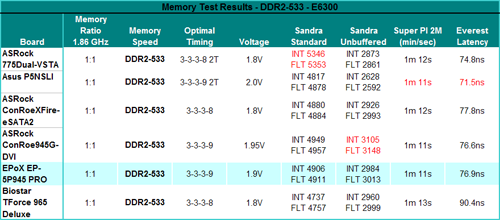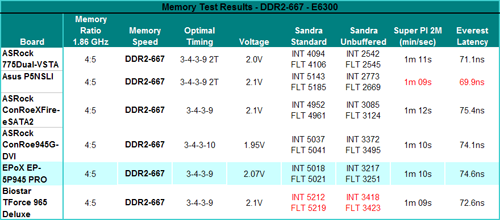EPoX EP-5P945 PRO: Budget 945P Performance
by Gary Key on September 11, 2006 4:45 AM EST- Posted in
- Motherboards
Test Setup
Our test setup for "budget motherboards" such as the EPoX is not the same configuration we use for performance motherboards. We are using the test configuration from our recent Core 2 Duo memory performance articles since we had a base of information with the E6300 and several competing Intel and VIA based motherboards. Also, this test configuration is well suited for this board's capabilities and would be considered a mainstream solution in regards to the overall system cost.
Our configuration was operated at a resolution of 1024x768 with high quality settings for each graphics benchmark. We are testing our motherboards at the fastest stable timings we can achieve and still pass our benchmark test suite. By increasing the memory voltage on the EPoX board we were able to run our Transcend modules at 3-3-3-9 at DDR2-533 and 3-4-3-10 at DDR2-667. Using memory ratios our CPU speed remains the same at 1.86GHz in the test platform, allowing us to get a good view of how memory bandwidth affects performance on these chipsets. Our memory settings were derived from extensive stress testing with a variety of applications. While certain settings that allowed lower latencies worked well with some applications, the final settings we arrived at had to work with all applications.
The Sandra Bandwidth Unbuffered memory performance of the EPoX board is the second highest of our group at DDR2-533 (1:1 ratio) and third highest at DDR2-667 (4:5 ratio). The Unbuffered scores of the EPoX board increase by 8% when going from DDR2-533 to DDR2-667 which is near the same increase found on the ASRock ConRoeXFire-eSATA2. However, the P965 equipped Biostar board scales at a rate of approximately 15%. The buffered memory scores are very competitive with the other solutions but we usually find these scores do not correlate well with real application performance.
In other synthetic testing, the EPoX board scores very well in our SuperPI 2M tests where it ties the Asus P5NSLI in the DDR2-533 results and places second in the DDR2-667 test. The latency results are average but improve upon the ASRock ConRoeXFire-eSATA2. A very good guide to understanding how the chipset, memory, and CPU relate to each other on Intel chipsets is located here.
Our test setup for "budget motherboards" such as the EPoX is not the same configuration we use for performance motherboards. We are using the test configuration from our recent Core 2 Duo memory performance articles since we had a base of information with the E6300 and several competing Intel and VIA based motherboards. Also, this test configuration is well suited for this board's capabilities and would be considered a mainstream solution in regards to the overall system cost.
| EPoX EP-5P945 PRO Performance Test Configuration |
|
| Processor: | Intel Core 2 Duo E6300 (1.86GHz, 2MB Unified Cache) |
| RAM: | 2 x 512mb Transcend JetRam DDR2-533 Tested at DDR2-533 3-3-3-9 1.90V |
| Hard Drive: | Seagate 320GB 7200RPM SATA2 16MB Buffer |
| System Platform Drivers: | Intel - 8.0.1.1002 |
| Video Cards: | 1 x EVGA 7600GS |
| Video Drivers: | NVIDIA 91.31 WHQL |
| CPU Cooling: | Cooler Master X-Dream P775 |
| Power Supply: | OCZ GameXstream 700W |
| Motherboards: | ASRock 775Dual-VSTA (VIA PT880Pro) ASRock ConRoeXFire-eSATA2 (Intel 945P) ASRock ConRoe945G-DVI (Intel 945P) EPoX EP-5P945 PRO (Intel 945P) |
| Operating System: | Windows XP Professional SP2 |
| . | |
Our configuration was operated at a resolution of 1024x768 with high quality settings for each graphics benchmark. We are testing our motherboards at the fastest stable timings we can achieve and still pass our benchmark test suite. By increasing the memory voltage on the EPoX board we were able to run our Transcend modules at 3-3-3-9 at DDR2-533 and 3-4-3-10 at DDR2-667. Using memory ratios our CPU speed remains the same at 1.86GHz in the test platform, allowing us to get a good view of how memory bandwidth affects performance on these chipsets. Our memory settings were derived from extensive stress testing with a variety of applications. While certain settings that allowed lower latencies worked well with some applications, the final settings we arrived at had to work with all applications.
 |
 |
| Click to enlarge |
The Sandra Bandwidth Unbuffered memory performance of the EPoX board is the second highest of our group at DDR2-533 (1:1 ratio) and third highest at DDR2-667 (4:5 ratio). The Unbuffered scores of the EPoX board increase by 8% when going from DDR2-533 to DDR2-667 which is near the same increase found on the ASRock ConRoeXFire-eSATA2. However, the P965 equipped Biostar board scales at a rate of approximately 15%. The buffered memory scores are very competitive with the other solutions but we usually find these scores do not correlate well with real application performance.
In other synthetic testing, the EPoX board scores very well in our SuperPI 2M tests where it ties the Asus P5NSLI in the DDR2-533 results and places second in the DDR2-667 test. The latency results are average but improve upon the ASRock ConRoeXFire-eSATA2. A very good guide to understanding how the chipset, memory, and CPU relate to each other on Intel chipsets is located here.










23 Comments
View All Comments
Zoomer - Monday, September 18, 2006 - link
While anandtech regularly bashes ATi/nVidia for paper launches, wouldn't this be a paper launch too? I can't find it for sale on the egg nor any other site.Gary Key - Wednesday, September 27, 2006 - link
I have contacted EPOX about supply, we purchased a retail board from NewEgg for comparison but according to our sources they do not have a firm delivery date so the board was pulled until an ETA is available.
Stele - Wednesday, September 13, 2006 - link
By the way, another noteworthy point of this review is the superb photography used. The level of detail and focus are excellent, and furthermore there is sufficient, white ambient lighting used so that the board isn't covered in off-colour shadows as if it were photographed under a sofa in the evening or something....While some people would dismiss the quality of motherboard photography as a non-issue, for some of us it's important to be able to see up close and gauge at least the layout of various components, connectors etc (better still if we could even see the details of certain components, as was very much the case in this review) without having to actually find a real sample of the board.
Stele - Tuesday, September 12, 2006 - link
Good review, as can be expected from Anandtech :)However, I would just like to point out a little misnomer that's becoming distressingly popular on the web... those little bare-metal capacitors are not called "solid state capacitors". They are, in fact, just aluminium electrolytic capacitors. The difference is that generally, the electrolyte used is of a solid type, rather than the liquid electrolyte the 'traditional' aluminium electrolytic capacitors contain.
Hence, if you want to differentiate them from the 'traditional' electrolytic capacitors, you could perhaps call them 'solid electrolytic capacitors' but certainly not 'solid state'... that is an old term used to describe circuits that do not use vacuum tubes, during the advent of transistors.
yyrkoon - Wednesday, September 13, 2006 - link
Suface mount, according to an EE buddy of mine.Stele - Wednesday, September 13, 2006 - link
I agree with him perfectly. As much as he's right if he were to call the components in question 'capacitors'. :)
Surface mount just means it's soldered onto the surface of the motherboard's PCB rather than using the traditional thin 'legs' that poke through holes in the PCB (such a component and mounting technology are called 'through-hole'). As such, while surface mount is an accurate description of the capacitors, it describes another aspect of the components in question altogether :)
However, because it is an accurate description nevertheless, calling these capacitors 'surface mount' is therefore actually more accurate than calling them 'solid state' ;) Yet the point reviewers are trying to make is not so much that the capacitors are surface-mount, but that they are not the traditional liquid electrolytic type that are more prone to leakage and failure under prolonged exposure to harsh operating evironments (thermally and electrically). Hence, the focus is more on the electrolyte type - solid vs. liquid - rather than surface-mount vs. through-hole.
blckgrffn - Monday, September 11, 2006 - link
I appreciate this timely review. I was trying to decide whether the GF was a getting a x2 or a Core Duo, and this board is going to solve my dillema.If only they had stuck the ICH7R or even just a 2 or 4 port SATA raid controller on there, as the lack of raid is really bogus now. A lot of my customers/friends want RAID1 for redundancy. I know this can be done in software, but hardware raid is much more transparent.
This board would be a no brainer if it included RAID.
Thanks again,
Nat
yyrkoon - Monday, September 11, 2006 - link
Well, of course I cannot speak for you, or anyone else, but in my opinion, RAID 1 is a bad idea for anyone who is likely to muck up a system. I find that non RAID (possibly USB drive backups, or whatever else you preffer), are often better, and have greater flexability. Another thing to note, is that if Windows isnt nessisary, Linux / BSD RAID 0,RAID 1 is nearly, if not just as fast as Hardware RAID. Also, incremental ghosting of a system drive is another option which is much more flexable.Basicly, the only real reason for RAID 1, is in the event of hardware failure, and if you purchase with this in mind, there is no reason why a HDD cant live for 5-8 years easily.
blckgrffn - Monday, September 11, 2006 - link
Try telling users with 100's of gigs of photos or videos that there HD should have lasted 5 years, not 5 months. I have already been there and it isn't comfortable. There is a reason dell is offering RAID 1 on nearly every desktop model they have. It's the easiest, most transparent way to send your MTBF into the stratosphere.Second, my $80 EVGA SLI mobo has all those features, as do many AMD catered motherboards. In the past, Intel boards have also come down to reasonable levels.
I stoutly refuse to spend more on a mobo than a processor, sorry. And I am not paying $150 for a board that has been gutted of features expected of a high to medium end motherboard.
Nat
yyrkoon - Monday, September 11, 2006 - link
And yes, we run a PC buisness here also, and have yet to see a HDD reguardless of how bad off, that we couldnt pull the data off. Most of the time, you just put the drive in another machine, pull the data off, and thats that. Once in a blue moon you have to send the drive off to have a company equiped with the hardware to get at the data, but that is extremely rare. RAID 1 wont work for an accidental deletion, and the like, thats where its the buisness owners responcability to educate average PC users for each situation, and not just try to make a quick 10%-15%(on a HDD) by selling another drive.